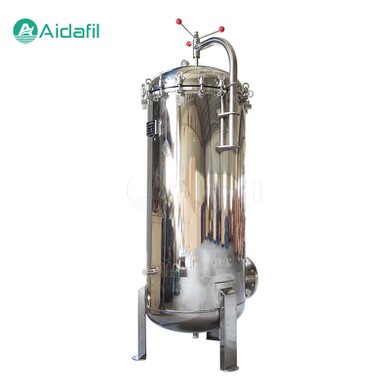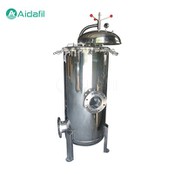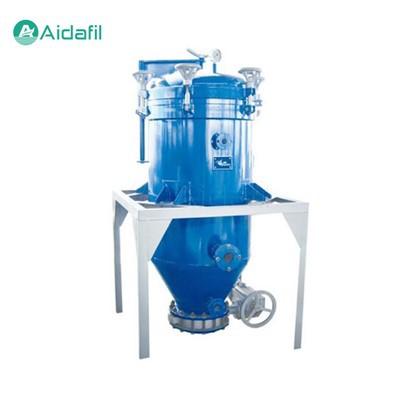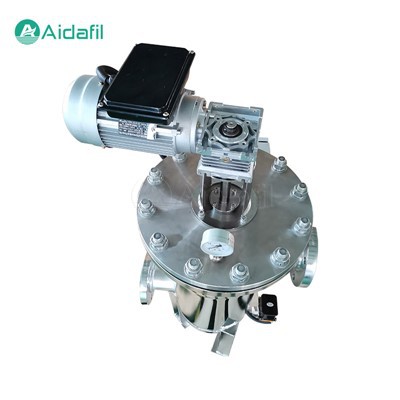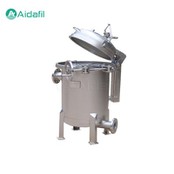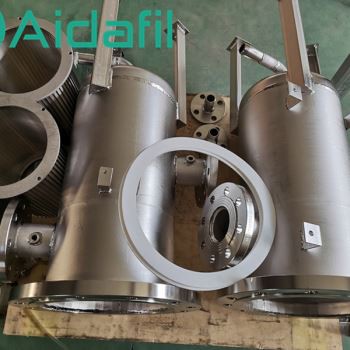
Top Quality High Flow Filter For Solid Particles Removal
Product Details
Fluids play a crucial role in various industrial processes, ranging from water treatment to chemical production. However, to ensure optimal performance and longevity of equipment, it is essential to remove solid particles from these fluids. This is where high flow filters come into play, offering efficient and reliable filtration solutions.
The Top Quality High Flow Filter For Solid Particles Removal is installed in the pipeline to remove various solid particles from the fluids. For example, it can be installed in front of the reverse osmosis system as a security filter, or in stalled at the end of the entire filtration system as a precision filter.
This kind of filter is constructed with durable materials capable of withstanding high pressure and flow rates without compromising on filtration efficiency. It can maintain high flow rates without significant pressure drop. This is achieved through innovative designs that maximize surface area for filtration without impeding fluid passage. Pleated filter elements, for instance, offer a large filtration area within a compact space, allowing for efficient particle capture while maintaining low differential pressures.
Parameters
|
Filtration precision |
0.003 micron-100 micron |
|
Temperature resistance |
80°C |
|
Pressure resistance |
1.6Mpa |
|
Flow rate |
0.1~500M3/H |
|
The number of filter elements |
3~300 |
|
The length of filter element |
250, 500, 750, 1000mm |
Key Features of a Top Quality High Flow Filter
1. High Flow Capacity
The filter should possess a high flow rate to accommodate the specific flow requirements of the application. This ensures that the fluid flows through the filter without causing excessive pressure drop or compromising the filtration efficiency.
2. Efficient Solid Particle Removal
The filter should effectively remove solid particles of various sizes and concentrations from the fluid. This requires a filter media with a high dirt-holding capacity and a suitable pore size to capture the target contaminants.
3. Low Pressure Drop
The filter should exhibit a low pressure drop to minimize the energy consumption associated with pumping the fluid through the filter. This is achieved by optimizing the filter media and design to reduce flow resistance.
4. Durable Construction
The filter should be constructed from durable materials that can withstand the operating conditions of the application. This includes resistance to corrosion, temperature extremes, and mechanical stress.
5. Easy Maintenance
The filter should be designed for easy maintenance and servicing. This includes features such as quick-release connections, simple filter element replacement, and accessible cleaning mechanisms.
6. Modular Design
Modular designs allow for flexibility and scalability in filtration systems, enabling users to customize the setup according to their specific needs. This includes adding or removing filter elements to adjust flow capacity or changing filter media to accommodate different filtration requirements.
Applications and Industries
The Top Quality High Flow Filter For Solid Particles Removal finds application in a myriad of industries and processes:
1. Petrochemical. In refining processes, they protect critical equipment like pumps, valves, and heat exchangers from fouling and corrosion.
2. Pharmaceutical. They ensure the purity of process fluids and water used in drug manufacturing, meeting strict regulatory standards.
3. Food & Beverage. Critical for removing contaminants from water and other process fluids, ensuring product safety and quality.
4. Power Generation. Used in cooling systems to maintain turbine efficiency and prevent damage from debris.
5. Semiconductor Manufacturing. Essential for ultrapure water systems required in chip fabrication, where even minute particle contamination can be catastrophic.
Selection Criteria
Selecting the right high flow filter involves considering several factors:
1. Flow Rate and Pressure Drop. Determine the required flow rate and acceptable pressure drop to ensure the filter can handle the system's demands without causing undue strain.
2. Filtration Efficiency. Identify the target micron rating based on the level of purity required for the specific application.
3. Compatibility. Ensure the filter material is compatible with the fluid being filtered, avoiding any chemical reactions or contamination.
4. Maintenance Requirements. Consider the ease of maintenance, including accessibility, replacement frequency, and availability of spare parts.
5. Cost and ROI. Evaluate total cost of ownership, including purchase price, maintenance, and potential savings from reduced downtime and extended equipment lifespan.
FAQ
1. Q: What is the function of a filter?
A: The main function of a filter is to remove solid particles, impurities, and harmful substances from liquids or gases, in order to achieve purification, clarification, and protection of equipment.
2. Q: How to choose a suitable filter?
A: When choosing a filter, factors such as the properties of the material being filtered (e.g., viscosity, temperature, corrosion), required filtration accuracy, processing capacity, operating pressure and medium, as well as the type, material, size, and installation method of the filter should be considered.
3. Q: What is the working principle of a filter?
A: The working principle of a filter mainly relies on physical screening, deep interception, absorption, or chemical reactions to remove impurities or harmful components from the material being filtered.
4. Q: How to maintain and care for a filter?
A: Maintenance of filters includes regular cleaning or replacement of filter elements, inspection of seals and fasteners, maintaining stable operating pressure, and avoiding overloading. Specific methods should be referenced from the filter's instruction manual and maintenance guides.
5. Q: What is the service life of a filter?
A: The service life of a filter depends on its working environment, processing volume, and filtration accuracy. Generally, when the filter's pressure drop reaches a certain value or the filtration effect decreases significantly, it needs to be replaced or cleaned.
6. Q: What should be paid attention to during filter installation?
A: During filter installation, attention should be paid to the directionality, ensuring that the fluid enters and exits from the correct ports. Also, the piping system should be cleaned before installation, and the filter should be securely fastened and sealed as required by the instructions.
7. Q: What is the replacement cycle for filters?
A: The replacement cycle for filters depends on their working conditions and filtration requirements, and is usually indicated by pressure difference indicators or timers. When the filter's pressure drop reaches the set value or the filtration effect decreases, it should be replaced in a timely manner.
Why Choose Us
· Professional manufacturer with many years' experience
· Good quality with competitive price
· OEM & ODM are welcome
· Various payment items are acceptable
· Good service by experienced manager
AIDA Philosophy
1. Management Concept:
· Satisfy the customers' demand --- Touch customers, trust with our products and services
· Make employees happy --- Pursue higher material and spiritual happiness
2. Company Mission:
· Focus on customer needs, provide best filtering solution
· To be the lifelong partner with customers
3. Corporate Vision:
· Become a global purification leadership brand
4. Values:
· Customer: Pursue the ultimate experience, enjoy excellent quality
· Team: Trust, responsibility, growth, win-win
· Work: Simple, sincere, efficient, dedicated
Hot Tags: top quality high flow filter for solid particles removal, China, factory, price, buy, stainless steel fiber sintered metal fiber felt, 0 01um coalescing filter element, durable lube oil filter elements, Lubricating Oil Filter Element, 15um machine oil filter, glass fiber oil separator filter

